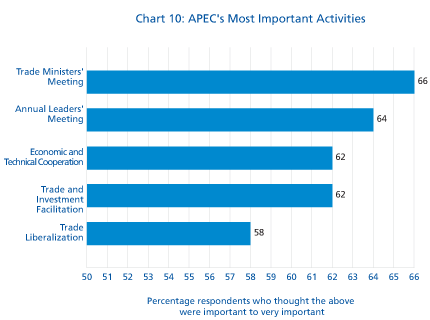Section 2: Regional Dynamics: Challenges for Asia Pacific Cooperation
Despite what seems like a benign environment, the region faces a number of emerging challenges. Some of these challenges derive in part from the previous decades of success in economic reform and trade liberalization. The ability to pursue further reform and market opening and achieve APEC's longer-term vision of a prosperous and peaceful Asia Pacific depends on economies addressing these challenges.
These issues include potential political and social tensions arising from a backlash against globalization, resource vulnerabilities and constraints, and international rivalries. While individual economies are seeking to address these issues, we are concerned that there has not been sufficient urgency attached to cooperative endeavors through regional institutions.
2.1 Challenges to Global and Regional Integration
Inequality a Threat to Continued Integration
In the face of growing inequality in many Asia Pacific economies, there is increasing debate on the costs and benefits of globalization and on the role of government in mitigating the negative effects of openness to the global economy.According to the IMF, there has been a broad and pronounced rise in income inequality across Asia over the last ten years. Inequality has increased in 13 of the 18 Asian economies studied by the IMF, with four economies unchanged and only one showing an improvement.
there has been a broad and pronounced rise in income inequality across Asia over the last ten years
Economies have also become more polarized, with distinct economic groups emerging in many low and middle income countries in Asia. Furthermore, there is evidence of a shrinking middle class in most ofAsia's low and middle income economies.
Benefits of Globalization Need to Be Spread
In response to this worrying trend,APEC leaders agreed at their meeting in Busan, Korea in November 2005 to "launch a study of ways to confront the challenges and impediments related to socio-economic disparity issues". The Chairman of the U.S. Federal Reserve,Ben Bernanke argues that further progress in global economic integration should not be taken for granted and that policy-makers need to do more to ensure that the benefits of globalization are more widely spread within their countries.China's leaders are also placing great importance on this issue, stressing social harmony as a goal of Chinese society.
Marginalization Adds to International Tensions
Even in the absence of growing inequality, the region as a whole continues to be home to vast pockets of people living below the poverty line. Despite decades of high growth and a sharp fall in absolute poverty in many economies, a large proportion of the region's population in East Asia, Southeast Asia, and Latin America continues to subsist on very low incomes. In places where poverty is concentrated among minority ethnic or religious communities, there is an added risk of marginalization and social conflict. These communities are also more susceptible to terrorist recruitment.
2.2 Short and Long-Term Risks
Resource Sutainability
Our PECC survey of regional opinion suggested that the greatest single issue of concern is energy security. Eighty- four percent of respondents to PECC's 2006 survey of opinion leaders chose this item as a major long-term risk, with North
American respondents expressing the most concern, at 95 percent.Adequate supplies of clean water are also of deep concern coming second to energy at 78 percent.
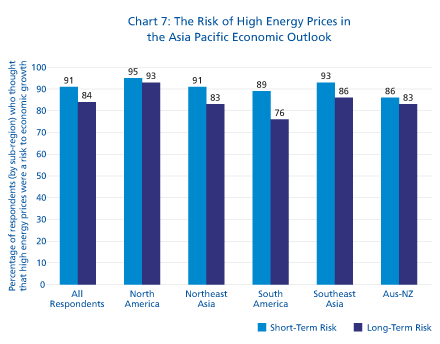
Energy security implies adequate supplies at reasonable prices. Despite some surplus economies such as Russia, Canada,Brunei and Malaysia, the PECC region runs a huge oil deficit, most of which is supplied from the Middle East. While the region's economic performance has continued in the face of the oil price increases of the past three years, the tight markets have resulted in competitive efforts to secure longer-term contracts for both oil and natural gas.
In fact, supply issues are best addressed cooperatively. Much effort has to be devoted to ensuring that "energy security" is conceived in international and regional terms so that the focus is on the compatibility of national policies towards investment in exploration production, and distribution, and not on a misleading identification of "security" with autarky. Energy efficiency is another area of common interest.
Still, the underlying longer-term questions need more attention: What is the best adaptation path, national and regionally, to the likely rise in the relative price of energy? How will relatively more valuable resource supplies impact regional and international relations? Will a need to have good relations with oil producers alter national interests and the foreign policies of countries and economies in the region, and exacerbate tensions in the region? Will innovation change the potential influence of oil and gas producers?
As serious a problem as air pollution is for many cities in developing Asia Pacific economies, water may be the biggest longer-term environmental issue. Industrialization, more intensive agricultural use, deforestation, urban pollution, and population growth have increased the stress on water supplies throughout the region. Water tables are falling in many areas, such as northern and northeastern China, where 44 percent of China's population lives, but which has only 14 percent of China's total water resources.
Access to potable supplies is a problem for many of the region's poor, including an estimated 100 million in Indonesia and 300 million in China, according to statistics in these economies. This is a major health hazard, as in Peru, which has been battling cholera outbreaks. Most of the region's economies have made water a priority issue and can learn from each other's experiences.
Regional Views Diverge on Other Risks
The next most serious long-term risks cited in our survey were financial market volatility closely followed by terrorist acts and policy responses to such threats. However, there was some divergence between the sub-regions on their top 3 risks, while all sub-regions ranked energy as the highest risk, respondents from Southeast Asian economies were most concerned about water and then terrorism, opinion leaders from North America and Northeast Asia ranked water and financial market volatility as the more serious.Both Australia and New Zealand and South America included protectionism as a top 3 risk.
Despite the substantial media attention on avian flu and other health pandemics, respondents generally did not rank this issue as a major risk for the region. The exception is in Southeast Asia, where 82 percent of experts chose avian flu as a risk in the short-term economic outlook.(see sidebar: The Threat of Avian Flu)
The Threat of Avian Flu
Avian flu has now spread from Asia to Europe and Africa, affecting more than 50 countries. The World Health Organization has reported 59 laboratory-confirmed human cases and 47 casualties in Asia in the first eight months of 2006. Indonesia alone has had 43 cases and 35 casualties, compared with 17 cases and 11 casualties for the full year 2005.
An Asian Development Bank (ADB) study estimates that the potential cost of a pandemic in Asia could reach $283 billion (or about 6.5% of GDP) in one year.Consumer spending on a wide range of services would contract significantly, as affected populations cut back on economic activity to reduce exposure to the virus.
The psychological impact of an outbreak is likely to be an important factor in economic losses, as was seen in the SARS outbreak of 2003. The decline in demand would result in business failures and spillover into lower investment and employment. Loss of human and physical capital would in turn reduce the region's long-run economic growth potential. Since Asia is an integral part of the global economy, even a localized pandemic can have far reaching effects.
On the social front, a pandemic flu would impact families and children in various ways. Many families in Asia depend on backyard poultry as a source of protein and income.Aserious outbreak would affect the nutrition and earning prospects of these families. Nearly half of the reported cases of avian flu involve children, which suggest a special vulnerability on the part of the young.Apandemic could push households below the poverty line and lead to greater overall inequality and social conflict.
There are a number of challenges in stopping the virus, which spreads primarily through poultry trade, and to a lesser extent through the migration of birds. The risk of poultry to human transmission is high due to the prevalence of backyard chicken farms in rural areas, and wet markets in urban areas where birds are openly slaughtered and displayed. The problem is exacerbated by inadequate health infrastructure, especially in rural areas, which increases the chance of an outbreak going undetected and rapidly spreading out of control.
There is a widespread agreement on the need for regional collaboration to fight the spread of avian flu. Donor countries and international funding agencies have pledged substantial sums for disease prevention and control. In January 2006, a high-level conference on bird flu was held in Beijing, at which the international community pledged $1.9 billion for such activities. Despite these commitments, the risk of a pandemic in the region remains high, whether from avian flu and another future virus.
Longer-Term Risks
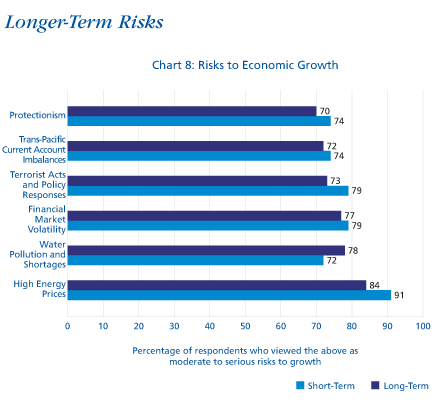
Threat of Protectionism
The combination of an economic slowdown, a stubbornly high current account deficit, the suspension of Doha negotiations, and political factors could also result in renewed protectionism, with major effects for the economies of the region,
Trade liberalization remains an important tool for addressing questions of poverty. In this respect, the suspension of the Doha Development Round is a major blow to the economies of Asia Pacific, especially the developing economies. We believe that leaders of the major APEC economies should take coordinated action to achieve a satisfactory outcome, APEC as a whole could make a great contribution if it could come up with an APEC set of offers, but the United States, China, and Japan must lead the way
The Doha Round and Its Alternatives
The much lamented but not entirely unexpected breakdown in the WTO Doha Round negotiations has thrown into sharp relief the absence of a credible non-discriminatory route to the achievement of APEC's Bogor goals of free trade and investment.
Despite the widespread calls for an early resumption of negotiations, it is not clear that sufficient political will exists to achieve a conclusion of the round in 2007, before the expiry of Trade Promotion Authority in the United States. The sheer volume of technical work that needs to be completed if a conclusion is to be reached by mid-2007 also presents a formidable challenge. On the other hand, a lengthy suspension of negotiations carries serious risks: Trade Promotion Authority may not be renewed and the political climate for the negotiations may deteriorate instead of improving.
Achieving a successful conclusion to the Round remains a vital objective for the Asia Pacific region and for the global economy. World trade continues to be plagued by problems, especially in agriculture, that can probably only be resolved in the WTO.Astill more important reason is the need to sustain confidence in the WTO on the part of its members.Commitment by large and small economies alike to a rules-based multilateral trading system remains a vital element underpinning the global economic architecture.
Meanwhile, preferential trade agreements (PTAs) continue to proliferate in the Asia Pacific region.Counting agreements currently under negotiation, there are soon likely to be over 40 PTAs, most of them bilateral, operating in the region, and proposals for still more continue to emerge.Although few if any observers claim that proliferation of PTAs represents a sensible basis for the organization of regional and global trade, the trend is driven, among other factors, by the powerful "domino effect" that is created by competition between economies for market access. Foreign policy and political objectives are also major driving forces.
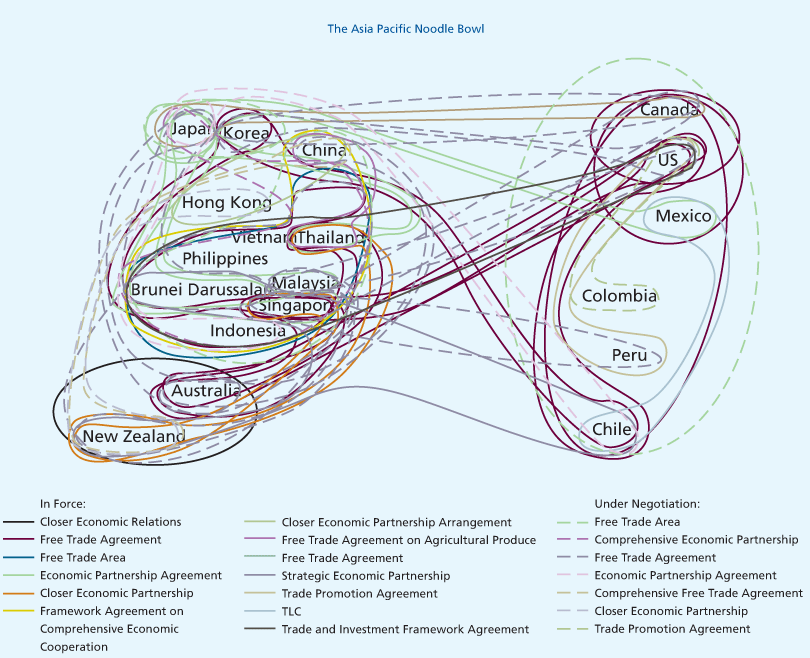
One hopeful development is the gathering debate over the negative effects of market fragmentation and increased business transaction costs created by a "spaghetti bowl" of PTAs.APEC's project to develop "model measures" for the design of PTA chapters is one potential contribution toward convergence of existing agreements, although some argue it is a case of "too little too late". PECC is working to develop more accurate assessments of the impact on business.
Another avenue to convergence is offered by the proposals for region-wide PTAs that are at various stages of exploration and that could in principle subsume many of the region's bilaterals.An East Asian FTA(EAFTA) covering the "ASEAN Plus Three" group has been under study for several years, and a further study has this year been prepared for the group's ministers and leaders. More recent proposals have been for an agreement extending beyond the "ASEAN Plus Three" group to include the additional participants in the East Asian Summit process (Australia, New Zealand and India) and for a Free Trade Areaofthe Asia Pacific (FTAAP) potentially embracing all APEC members.
Resistance to the liberalization of trade between the major APEC economies, heavily grounded in political sensitivities, tensions and rivalries, remains a formidable obstacle to the realization of each and any of these proposals. Meantime, more limited "ASEAN Plus" FTAs - concluded already by ASEAN with China and Korea, and under negotiation with Japan,Australia and New Zealand, and India - have emerged as alternatives, or possibly precursors to region-wide agreements based on the "ASEAN Plus Three" or East Asian Summit groupings. In the trans-Pacific context, negotiations for an agreement between the USA and Korea are an important development that could, if successful, catalyse further important preferential trading initiatives among the major APEC powers.
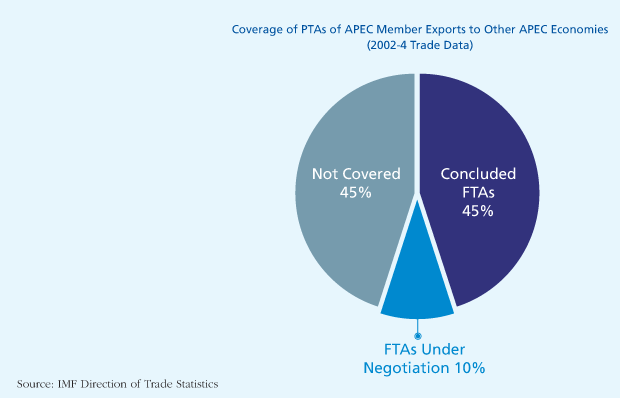
Relations among Large Economies
Strong relations among the economies of the region, particularly the three major North Pacific economies of Japan, China, and the United States are key to effective regional action. The continued rapid growth of the Chinese economy is the most important single transformational force in the Asia Pacific region in the first decade of the 21st century.
This is a powerful and positive element of dynamism for the region as a whole, but it also requires political and economic adjustments of the other economies.Cooperation and cooperative leadership among the larger economies, especially China, Japan, and the United States, are essential to smooth economic and political adjustment processes, and ensure the viability and strengthening of trans-Pacific and East Asian regional cooperation institutions. With its steady rise as a major political and economic player in the region, China intends to play a commensurately greater leadership role. Japan, too, is taking a more active interest in regional affairs as its economy shows signs of renewed vitality.
The challenge for both great East Asian powers is to ensure that these roles are compatible with each other and with the aspirations of other economies in the region. This is not only important for economic progress, but also to help resolve troubling regional issues, such as the North Korean nuclear issue.
The relationship among the larger powers has recently improved, and we hope this trend will continue to be consolidated, both bilaterally and through cooperation in sub-regional and regional activities. The main recent development has been the resumption of leaders meetings between China and Japan. Moreover, all the major powers were able to agree on a common approach through the United States following the North Korean nuclear explosion
American perceptions of China's rise and China's perceptions of U. S. responses will be critical to the future of trans-Pacific relations. The two economies have strong economic and political relations, but there are nationalist instincts on both sides that will jump at any opportunity to advance a narrow domestic agenda, at the expense of diplomatic and economic ties. While other economies have little influence over this relationship, there is a role for regional institutions to make space for the deepening and broadening of Sino-American ties.
there is a role for regional institutions to make space for the deepening and broadening of Sino-American ties.
2.3 Policy Priorities for Regional Cooperation
Looking to the future, the survey provides some guidance on key policy priorities for regional cooperation. There is little to separate the top four priorities, which are reducing tariff barriers, ensuring energy security, reducing corruption and improving transparency, and cutting red tape. Tariff reduction and cutting red tape (which is related to trade facilitation and regulatory reform) are traditional areas of strength for APEC. Based on the survey findings, there is a case for APEC to place more emphasis on energy security and transparency in its work program.
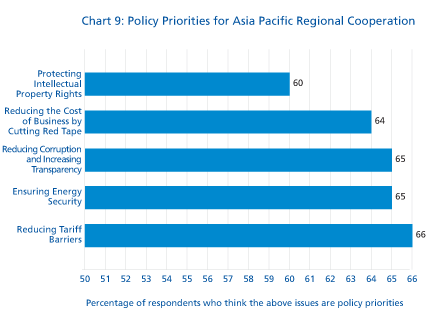
There was considerable regional variation in the results. Whereas North American respondents chose corruption/transparency and intellectual property rights as the most important policy priorities, Southeast Asian respondents were more concerned about cutting red tape and ensuring energy security. Energy security was the top pick for Northeast Asian respondents, whereas Australia/New Zealand respondents put this item at the bottom of their priority list.
By a wide margin, South American respondents identified tariff barriers as the top policy priority, which likely reflects the widespread concern over impediments faced by exporters from the region in getting their products, especially manufactured goods, to market.
APEC Activities - need for reform?
When asked about various aspects of APEC's agenda, the trade ministers'and leaders'meetings were selected as "important or very important" by the largest number of respondents. Reform of APEC's internal processes, strengthening its implementation track record, stepping up trade and investment facilitation and ecotech and capacity-building initiatives, all of which have been mooted within the organization, are a start to reinvigorating APEC.
Respondents to our survey placed more importance on economic and technical cooperation as well as trade facilitation than on trade liberalization. Fewer than half the respondents chose the APECCEO Summit, Peer Review, and the Individual Action Plans as important or very important agenda items. In fact, the number of respondents who felt the Individual Action Plans were not important or only somewhat important was more than double that of those who felt they were important.
However, large numbers of respondents to our survey doubted the commitment member economies have to the APEC process and therefore the ability of regional institutions to manage the risks outlined above which is discussed in the following section.
